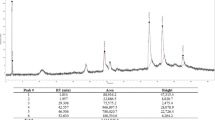Abstract
This study described the chemical synthesis and pharmacological evaluation of a series of N-(2-hydroxyethyl) cinnamamide derivatives. The structures of them were characterized by IR, 1H-NMR, MS and elemental analysis. Their antidepressant activities were evaluated by the forced swimming test (FST) and tail suspension test (TST). Pharmacological results of these compounds showed that some of them, given orally, significantly reduced the immobility time in the FST and TST, indicating the antidepressant-like action. Among them, compounds N-(2-hydroxyethyl)cinnamamide (1g), (E)-3-(4-hydroxy-3-methoxyphenyl)-N-(2-hydroxyethyl)acrylamide (1i) and (E)-N-(2-hydroxyethyl)-3-(3-hydroxyphenyl)acrylamide (1n), active in the two models, were considered as the most promising compounds in this study.




Similar content being viewed by others
References
Balsamo A, Barili PL, Crotti P, Macchia B, Macchia F, Pecchia A, Cuttica A, Passerini N (1975) Structure-activity relations in cinnamamides. 1. Synthesis and pharmacological evaluation of some (E)- and (Z)-N-alkyl-alpha,beta-dimethylcinnamamides. J Med Chem 18:842–846
Balsamo A, Crotti P, Lapucci A, Macchia B, Macchia F, Cuttica A, Passerini N (1981) Structure-activity relationship in cinnamamides. 3. Synthesis and anticonvulsant activity evaluation of some derivatives of (E)- and (Z)-m-(trifluoromethyl)cinnamamide. J Med Chem 24:525–532
Bourin M, Chenu F, Ripoll N, David DJ (2005) A proposal of decision tree to screen putative antidepressants using forced swim and tail suspension tests. Behav Brain Res 164:266–269
Bruce Moffett R (1964) Central nervous system depressants. VI. Polymethoxyphenyl esters and amides. J Med Chem 7:319–325
Cryan JF, Markou A, Lucki I (2002) Assessing antidepressant activity in rodents: recent developments and future needs. Trends Pharmacol Sci 23:238–245
Cryan JF, Valentino RJ, Lucki I (2005) Assessing substrates underlying the behavioral effects of antidepressants using the modified rat forced swimming test. Neurosci Biobehav Rev 29:547–569
Guan LP, Su X, Deng XQ, Zhao, DH, Qu, YL, Quan, ZS (2010) N-palmitoylethanolamide derivatives: synthesis and studies on anticonvulsant and antidepressant activities. Med Chem Res. doi10.1007/s00044-010-9357-7
Hirschfeld RM (1999) Efficacy of SSRIs and newer antidepressants in severe depression : comparison with TCAs. J Clin Psychiatry 60:326–335
Lopez AD, Murray CC (1998) The global burden of disease, 1990–2020. Nat Med 4:1241–1243
Meyer C (2004) Depressive disorders were the fourth leading cause of global disease burden in the year 2000. Evid Based Ment Health 7:123–127
Petit-Demouliere B, Chenu F, Bourin M (2005) Forced swimming test in mice: a review of antidepressant activity. Psychopharmacology (Berl) 177:245–255
Porsolt RD, Bertin A, Jalfre M (1977) Behavioural despair in mice: a primary screening test for antidepressants. Arch Int Pharmacodyn Ther 229:327–336
Steru L, Chermat R, Thierry B, Simon P (1985) The tail suspension test: a new method for screening antidepressants in mice. Psychopharmacology 85:367–370
Thase ME (2003) Evaluating antidepressant therapies: remission as the optimal outcome. J Clin Psychiatry 64(Suppl 13):18–25
Thase ME, Corya SA, Osuntokun O, Case M, Henley DB, Sanger TM et al (2007) A randomized, double-blind comparison of olanzapine/fluoxetine combination, olanzapine, and fluoxetine in treatment-resistant major depressive disorder. J Clin Psychiatry 68:224–236
Van Heyningen E, Brown CN, Jose′ F, Henderson JK, Stark P (1966) N-monoalkyl-β-alkylcinnamamides as sedatives. J Med Chem 9:675–681
Acknowledgment
This work was supported by the National Natural Science Foundation of China (No. 30860340).
Author information
Authors and Affiliations
Corresponding author
Rights and permissions
About this article
Cite this article
Deng, XQ., Wu, D., Wei, CX. et al. Synthesis and antidepressant-like action of N-(2-hydroxyethyl) cinnamamide derivatives in mice. Med Chem Res 20, 1273–1279 (2011). https://doi.org/10.1007/s00044-010-9470-7
Received:
Accepted:
Published:
Issue Date:
DOI: https://doi.org/10.1007/s00044-010-9470-7



